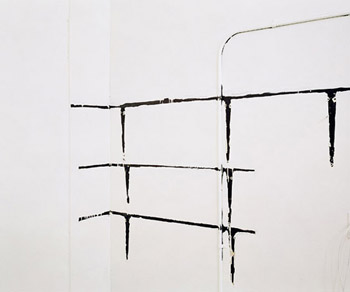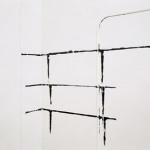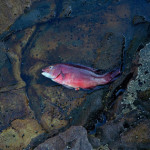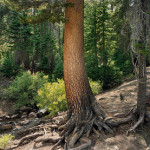By SHANE LAVALETTE
Mark Wyse is a photographer based out of Los Angeles, CA and teaches at UCLA. His book, 18 Landscapes, published by Nazraeli Press in 2005, focuses on the complexity of cultural perception and interaction and in an environment. He is represented by Wallspace in New York. He spoke with photographer Shane Lavalette in October, 2007.
----
Shane Lavalette: Your project Marks of Indifference shares the same title as Jeff Wall's contribution to the catalog for Reconsidering the Object of Art: 1965-1975 at the Museum of Contemporary Art, Los Angeles - Wall's 1995 essay on the intersection of photography and conceptual art. I can see how this article seems fitting to your work, but can you elaborate on what this discussion means to both you and the series of photographs that you've chosen to associate with it? How might this essay provide a way of "reading" your images?
Mark Wyse: The title came about halfway through the series. Talking about it now makes it seem as if I was actually conscious of what I was thinking about at the time I started to make the photographs. This wasn't the case, but as the project progressed I found myself continually attracted to the photographs that seemed to be caught between reflecting on the nature of photography and being depictions of the world. Each of the photographs has a different relationship to the words "marks of indifference." In one respect, the work seeks to literally depict "marks" or "traces" of indifference that exist out in the world. On another level the work fails to function so literally. It seeks to reflect on itself. Some of the photographs speak to "marks of indifference" as a subject of society. Others speak to "marks of indifference" as a reflection on photography, and in that regard, to Jeff Wall's essay. The work was meant to explore these conflicting tensions, to suspend this relationship in the hope that the photograph might have some meaning elsewhere.
SL: Since reading your essay The Materiality Complex, I've been thinking about what you refer to as a "longing for the reality behind representation." Can you talk about this in relation to your own photographs? How would you in simple terms describe the distinction between transparency and transparent meaning?
MW: I don't know. It's a little messed up. I was trying to think through this when I was making the Marks of Indifference pictures. Transparency is such a convoluted word. I was trying to separate in my head the experience of seeing with the meaning of what one sees. That there was a psychological component to seeing reflected in photographs that had meaning for myself that was often at odds with the meaning of the subject of the photograph. That often we speak about a photograph's meaning in terms of its subject alone. I wanted to shift attention away from the subject towards the relationship between the subject and photographer.
This relationship I often find to be revealing in terms of the desires of the photographer. The camera's marks in themselves are "indifferent" in the sense that the camera can't help but depict what is in front of it, but the relationships established between the photographer and his or her subject are not, and often this is where the photograph's meaning resides. It is here embedded in the invisible surface of the photograph that the unconscious and conscious intentions of the photographer are revealed. But perhaps another way to explain my thinking outside the confines of photography is to relate it to the tension between having an experience and reflecting on an experience. I kept getting stuck thinking about which I valued more. Did I want my work to be a direct engagement unmediated by conscious thoughts or did I want it to reflect an acute awareness of what I was doing?
I find it so difficult to make relatively straightforward photographs that engage abstract thinking. Now of course I don't expect these ideas to be visible in the photographs, but the photographs are a byproduct of how I was thinking at the time both about photography as a medium and about life. Or rather by making the photographs I became consciously aware of how I was thinking about art and my relationship to reality.
SL: I love the account of viewing Marks of Indifference #1 (Shelf) as described in the press release to your show from last Spring at Wallspace:
Here, the viewer oscillates between seeing marks on photographic paper and seeing marks on a wall in a room… between seeing a pictorial abstraction and a representation of the real world… between seeing a piece of art and its social implications.
Having first discovered your photographs, I found myself struck by feelings of both perplexity and pleasure (delighted by the experience, as you mentioned, of simultaneously seeing and reflecting on the nature of representation itself). I believe this is both a result of your "photographic eye" and also your ability to produce a successful "photographic object." What does the surface of a photograph mean to you?
MW: It's funny that you mention "photographic eye" and I think I know what you mean, but several of the photographs from the Marks of Indifference work were made by putting the camera on the ground, hence never looking through it. I also did this with the series 17 Parked Cars in Various Parking Lots Along Pacific Coast Highway Between My House and Ed Ruscha's. My reason for doing so was because I kept thinking about photographs being caught between the indifference of the mechanical marks of the camera and the bodily sensation of looking through one's eyes. Photographs often for myself provide the experience of being inside one's self and outside one's self at the same time. They provide the experience of seeing oneself seeing, which for myself are why they are such revealing models. On the one hand photographs briefly suspend the perception of a maker and imply the subject speaking for itself and on the other they engage a connection through seeing.
To answer your question regarding the surface of photography, if you are talking about the actual material surface of photographs, I couldn't care less. Everyone pretty much uses the same paper so the surface is the same. If you are talking about surface as a means of thinking about the nature of the medium, that the surface is a reflection of many distinct relationships that are embedded with meaning, I care a great deal. I don't really think of my photographs in terms of objects, I think of them as containers of relationships. Yes, of course they are objects, but that is not what interests me.
SL:A consideration of the relationship between humans and the natural world seems to find a place in much of your work. How might this theme carry over into Marks of Indifference? In other words, if those photographs were to "speak" on this subject (and I believe they would as by nature all art is provided a "language") what would they say?
MW:I guess it's always there, the relationship between humans and nature, but it's interesting, I never think about the photographs that way. I don't deny it is there as a subject and as content, but it isn't necessarily what I think about. To give an example, in the Winter photographs I was thinking about 19th century ideas concerning Romanticism and Realism (and the birth of abstraction), how photography was born between the two and what those implications might mean for photography. I was trying through visual metaphor, by adopting and juxtaposing through photography various pictorial strategies of landscape painting used in the 19th century, to inject photography into the tension between a practice using the imagination as a subject against a practice using the contingency of the material world; between a practice using the hand and a practice using the eye.
I tried to replace the empathetic surrogate that Caspar David Friedrich so brilliantly employs as a figure seen from behind with the scopic gaze of the camera. I tried to depict the opaque masses of water lingering in the crevasses of weathered rock in a way that resonated with the foreboding darkness of Courbet's canvases. I was thinking, is a landscape a vehicle for internal reflection or simply a description of the cold, hardness of the earth? I also thought it would be interesting to photograph the coast off of Los Angeles as if it was the Baltic Sea. I was also feeling a bit grumpy that year and it just felt good to go out on overcast murky days to roam along the sea edge.
Now if you don't know me, and we haven't had this conversation you might not see any of these things at all. There is always a gap between our experiences and our reflection on those experiences and in the Winter photographs I was more concerned with providing an experience than an overt expression of my intentions. Maybe photography isn't so good at articulating intentionality. Its transparency gets in the way.
SL: It is transparency that hides our intentions?
MW: Yes, this is the anxiety of photography. However, just because a photograph has an illusion of being transparent, in the sense that we feel as if we are looking through it doesn't mean that the photograph's meaning is transparent. A photograph is often transparent but it's meaning is often opaque.
SL: A younger generation of photographers is still, as ever, deeply influenced by work that was being made in ‘70s. The photographers I'm thinking of often looked at "seemingly banal" subjects and found a way of presenting them in a new light, giving them new meaning. Would you say you are continuing the "tradition" of this approach? When you first discovered the work of Sternfeld, Shore or that of Eggleston, what was your response? Do you, in 2007, feel the same way?
MW: I am not so much interested in the problems Eggleston is interested in. In terms of earlier photographers I prefer Ed Ruscha. I prefer 26 Gasoline Stations over William Eggleston's Guide. I like Stephen Shore a lot. I have no idea if I am continuing that tradition or not.
SL: I'm thrilled that you were willing to take the time for an interview here. The online community has spawned quite a bit of critical discourse about photography. I'm wondering, in your free time do you read any blogs? What do you think of them?
MW: I just started reading a few blogs and have found them very engaging at times. It beats reading October.
SL: Out of curiosity, what is your degree from the University of Colorado?
MW: It is in accounting and economics. I did that one for my parents.
SL: You went on to receive an M.F.A. from Yale. Were your professors - Papageorge, Crewdson, diCorcia, and the rest - receptive to your ideas about image making?
MW: I tried talking about Ed Ruscha's photographic books while in school with my professors at Yale. It didn't go so well. But I imagine that's the point. You're not there to spit out the same bullshit.
SL: It's argued that being a product of years of "institutionalized art school" will produce a certain breed of artist. This is an interesting view to consider. Having graduated from one of the most prestigious photography-related institutions in the country and, now, being a teacher yourself at UCLA and CalArts, what is your take on the topic of whether art can/should be taught?
MW: I don't see how one can talk about art education without relating it to the specifics of each individual. In my experience there are those that thrive on art discourse in an academic setting and there are those that get killed in such an environment. In my eyes, the factors that tend to shape an interesting individual has little to do with the context that individual decides to surround himself in when he or she is in their twenties. I would say that the circumstances outside that individual's control, the situations and experiences lived at a much earlier age, tend to have much more significance.
SL: One of the best lectures I've seen by a photographer was a short presentation by Jason Fulford where he very eloquently discussed his images through literature and linguistics (without saying much about the actual pictures at all). Anyone familiar with Jason's work would not be surprised to hear that he's influenced by the writing of Samuel Beckett. What role would you say non-photographic media plays in influencing your art? What are you reading? What are you listening to?
MW: I imagine that for Jason speaking through literature and linguistics was more revealing about his process than talking about the photographs directly. By using literature and linguistics as a model it provided another form to draw attention to the relationships he's really interested in. Of course I am only speculating as I didn't hear Jason's talk, but I can relate to it. I am currently reading a book of interviews with people who work in cognitive science. It's called Conversations on Consciousness: What the Best Minds Think about the Brain, Free Will, and What It Means to Be Human. It sounds very fancy but the interviews are very accessible and in a language I can understand. When I am angry I listen to Minor Threat.
SL: What is it about cognitive science that interests you?
MW: I stumbled upon this guy Thomas Metzinger, a philosopher in cognitive studies who talks about the "self" and transparency. While perusing Amazon.com I came across this quote: "Nobody ever was or had a self. All that ever existed were conscious self-models that could not be recognized as models." Now I thought to myself, "That's interesting, but what the fuck? What does that mean?" So I bought his book Being No One: The Self Model Theory of Subjectivity. Beyond the first paragraph, I don't have a clue as to what the book is about or how he came to think that the self doesn't exist. But this idea of the "self" being an illusion I found fascinating. Fascinating in that I didn't know what exactly he meant by not having a self but could relate to it from the perspective that you can never really see yourself or understand yourself from the position of being yourself. I believe this is why we do things, make things, talk about things; it is this never-ending drive to understand our own relationship to reality.
SL: Would you say this is why we find ourselves making photographs?
MW: Yes, exactly. Art becomes a model of our relationship to reality. For myself photography is a good model because it engages the intentional and the unintentional, with things in your control and outside your control, it deals with yourself and the other.
I find this relationship highly compelling.
- Mark Wyse, Marks of Indifference #1 (Shelf), 2006 (from “Marks of Indifference”).
- Mark Wyse, Winter #4, 2005 (from “Winter”).
- Mark Wyse, Forest, 2000 (from “18 Landscapes”)
This interview was originally posted by Shane Lavalette on his blog, which features discussions on fine art photography, current exhibitions, books, films, and interviews with artists.
Mark Wyse
Shane Lavalette / Journal
All images are copyright and courtesy of Mark Wyse.







